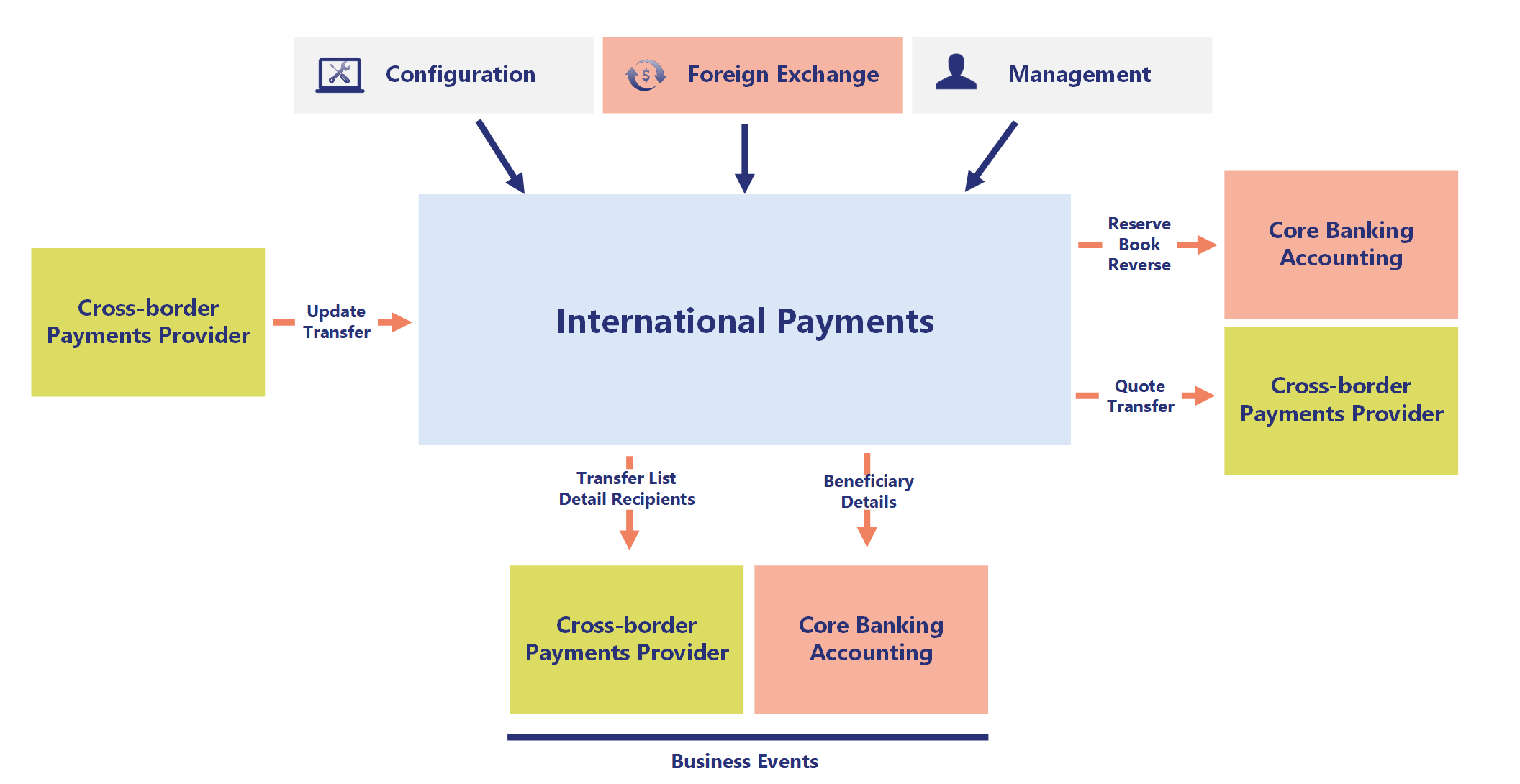International Payments Domain Adapter Guide
The International Payments Domain Adapter (IPDA) provides a standard interface for integrating Temenos Transact with a cross border payments provider. This guide shows developers how they can use these APIs to create card fulfillment solutions with external systems or proxy services using the generic adapter for integrations to Temenos Exchange.
The IPDA acts as the central hub in this architecture, orchestrating transaction workflows between external payment providers, beneficiary management systems, and core banking platforms. It ensures efficient, compliant, and accurate handling of international payments while offering management and monitoring capabilities for operators.
Context Diagram
This context diagram represents the interactions of the IPDA with its surrounding entities, focusing on the foreign exchange life cycle, events, and processes.
The context diagram shows the roles that access IPDA at the top and the external systems they access via it at the bottom. It shows the peer client systems sending incoming events at the left and the peer server systems receiving outgoing events at the right. Events can be either business events or data events. Note that this context diagram is primarily a diagram for run time, but includes the configuration role which is for design time. Solid lines are synchronous interfaces, dotted lines are asynchronous interfaces. Interfaces can be either for business events (coral) or for data events (blue).
Note: Click the diagram to expand. Each party featured in the diagram (roles, clients, servers) is described in more detail below.

Cross-Border Payments Provider
Client Role
This client represents external payment processors responsible for executing international money transfers. It acts as a bridge between the International Payments system and the global financial ecosystem.
Key Actions
- Update Transfer: Provides updates on payment status, such as processing, success, or failure.
- Quote Transfer: Offers real-time pricing and fee estimations for international payment requests.
- Transfer List Detail Recipients: Receives a detailed list of payment recipients for batch or individual transfers.
Flow
Status updates flow into the IPDA, ensuring transactions are accurately tracked and reconciled. Recipient details and payment requests are sent from the International Payments system for execution.
Configuration Role
Role
The configuration role is the administrative interface for managing operational parameters and system settings. It enables flexible adjustments to support business requirements.
Key Actions
- Define orchestration logic.
- Update system settings.
Flow
Configuration settings are input into the International Payments system, enabling dynamic adjustments without disrupting operations.
Foreign Exchange User Agent Role
Role
This role serves as the primary interface for bank customers to interact with the system. It enables users to request quotes, initiate transfers, and review details of past and pending transfers.
Key Actions
- Request Quotes: Users can fetch real-time exchange rate quotes for specific currency pairs and transaction amounts.
- Execute Transfers: Customers initiate cross-border payment requests by providing beneficiary details, transfer amounts, and currency information.
- Retrieve Transfer List and Details: Users can access a list of past and pending international transfers along with their statuses, amounts, and other relevant details.
Flow & Actions
The User Agent interacts with the International Payments system to perform these actions:
- Quotes and Transfers: The system validates the inputs, processes the requests, and sends back calculated quotes or transfer confirmation statuses.
- Transfer List and Details: The system fetches the transaction history or pending transfers from the appropriate data stores and returns it to the user.
Management Role
Role
This role provides observability and operational control over IPDA. It supports operators with insights into system health and enables fine-tuned debugging capabilities.
Key Functions
- Observability: Logs, metrics, and traces to monitor system behavior.
- System Management: Readiness checks, heartbeat monitoring, and state management.
- Diagnostics: Enable deeper logging or debug modes for issue resolution.
Flow
Management communicates with the IPDA to monitor and optimize its performance.
International Payments Domain Adapter Role
Role
The IPDA is the core orchestrator for cross-border transactions. It manages workflows, validates data, and integrates with external systems to ensure smooth processing.
Key Functions
- Transaction Processing: Handles payments from initiation to completion.
- Data Validation: Ensures recipient and transaction details meet compliance standards.
- Integration: Coordinates with providers, beneficiary systems, and accounting platforms.
- Event Handling: Manages and dispatches transaction events to relevant systems.
- Data Interaction: Receives transaction requests, processes them, and communicates with downstream systems. Sends master data updates to synchronize financial data.
Beneficiary Management System Role
Role
This service manages recipient data to ensure transactions are processed accurately and comply with local and international regulations.
Key Actions
- Validate recipient information such as names, addresses, and bank details.
- Provide up-to-date beneficiary records to the IPDA.
Flow
The system supplies beneficiary details to the IPDA for transaction validation and execution.
Related Guides
See also:

